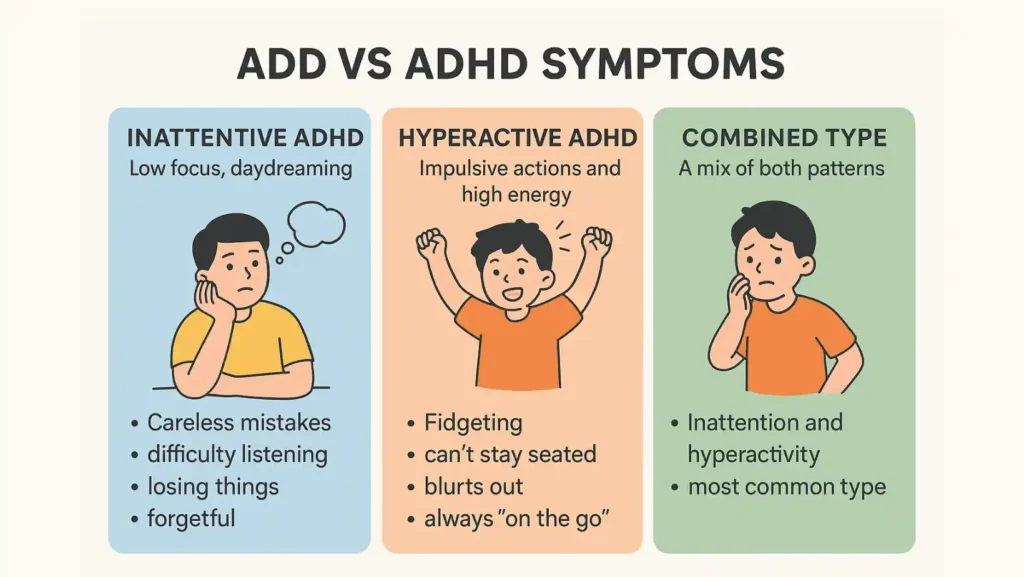The difference between ADD and ADHD lies in how symptoms appear. ADD, or Attention Deficit Disorder, was the older term used for people who struggled to focus but were not hyperactive. Today, the medical term ADHD (Attention Deficit Hyperactivity Disorder) includes both inattention and hyperactivity as possible patterns. The term ADD is no longer used officially, but it still describes what doctors now call “inattentive ADHD.”
Understanding the difference between ADD and ADHD helps you recognize symptoms, seek proper treatment, and improve daily functioning.
Table of Contents
ToggleWhat Is ADHD?
Definition and Overview
ADHD is a condition that affects how your brain focuses, controls impulses, and handles energy levels. When someone has ADHD, it means their brain system for attention and self-control works differently than average. It’s a neurodevelopmental disorder (which means it starts when the brain is developing).
How ADHD Affects Focus, Impulse Control, and Energy
If you have ADHD, you might find it hard to stay focused on a task that doesn’t interest you. You may get distracted easily. You might act without fully thinking things through (that is, impulsivity). You could feel more restless or have trouble staying still (that is hyperactivity).
For example, you may start doing homework, jump to your phone, forget what you were doing, then move on to something else. Impulse control and sustaining focus become major challenges.
ADHD in Children and Adults
ADHD often begins in childhood. Experts say symptoms must appear before age 12 (though people may not be diagnosed until later). In children, hyperactivity is more visible (“running around”, “can’t sit”). In adults, it may show as restlessness or internal mental motion rather than visible fidgeting.
Daily Life Impact
In school, a child with ADHD might get poor grades not because they’re not smart but because they can’t focus, lose things, or interrupt others. In adult life, you might lose track of time, miss deadlines, forget meetings, or struggle in relationships because of impulsive words or forgetfulness. Over time, this can lead to stress, low self-esteem, or trouble in career or relationships.
What Is ADD?
Meaning of ADD and Why It Was Used Before ADHD
ADD stands for Attention Deficit Disorder. It was used in older diagnostic systems to describe people who had attention problems without much hyperactivity. Back then, doctors saw two groups: those with hyperactivity and those without. The “without hyperactivity” group got the label ADD.
How ADD Describes Inattentive Behavior Without Hyperactivity
When someone had ADD, they often:
- Daydreamed a lot
- Were easily distracted
- Seemed quiet
- Didn’t act impulsively or move a lot
This is the inattentive pattern. For example, a student with ADD might sit quietly but stare out the window, miss parts of the lesson, or forget to hand in assignments.
Why “ADD” Is No Longer a Medical Diagnosis
Medical guidelines (specifically the Diagnostic and Statistical Manual of Mental Disorders, Fifth Edition or DSM-5) removed ADD as a separate label. Now the official diagnosis is ADHD, with subtypes. Experts found that splitting attention problems and hyperactivity into separate diagnoses was confusing.
How ADD Fits Under ADHD (DSM-5 Update)
Under the current classification, what used to be called ADD falls into the inattentive presentation of ADHD (formerly ADHD-I). That means: attention problems, minimal hyperactivity. The fact that ADD is no longer used as a separate diagnosis means you may see people say “I have ADD” even though formally their diagnosis is ADHD.
3 Types of ADHD
1. Inattentive Type (Previously Called ADD)
This type shows mainly difficulty in paying attention. You might: miss details, get easily distracted, have trouble organizing tasks, and often forget. There is little or no hyperactive behavior.
Example: You’re reading a story, your mind wanders, you skip paragraphs, and then realize you missed what happened.
2. Hyperactive-Impulsive Type
Here, the problems are mostly with movement and impulsive actions. You might fidget, talk a lot, interrupt others, act before thinking, and feel “on the go”. Focus may also be poor but hyperactivity and impulsivity dominate.
Example: During a meeting, you can’t stay still, you tap your foot, you start talking out of turn.
3. Combined Type
In this type, you have both strong inattentive signs and strong hyperactive-impulsive signs. Many people with ADHD fall into this combined category.
Example: You might drift off during tasks, lose track of your phone, and also interrupt colleagues or move constantly.
How These Types Differ in Kids and Adults
In children, hyperactivity is more visible (running in class, excessive talking). In adults, hyperactivity may show as restlessness, internal agitation, frequent job changes, and impulsive spending.
Inattentive type in adults may look like “zoning out”, forgetting bills, and procrastination. Understanding these types of differences helps when discussing the difference between ADD and ADHD in practical life.
ADD vs ADHD: What’s the Difference
Key Difference: Inattention vs Hyperactivity
When exploring the difference between ADD and ADHD, the main distinction is how much hyperactivity and impulsivity are present. ADD is referred to mainly as inattention without hyperactivity. ADHD is an umbrella term that includes inattention and hyperactivity-impulsivity.
ADD Symptoms
If you see these signs: trouble staying focused, avoiding tasks that require mental effort, losing things, daydreaming, then you might be looking at what used to be called ADD (now ADHD-inattentive). These symptoms often feel like low energy or being spaced out.
ADHD Symptoms
For ADHD (especially the hyperactive or combined types), you’ll find: fidgeting, trouble staying seated, blurting out answers, interrupting others, and acting quickly without thinking. These are classic ADHD features.
Why “ADD” Is Still Used Informally
Even though the clinical label no longer uses ADD, many people and even some professionals continue to say ADD because it feels familiar and simple. When you hear someone say “I have ADD”, they likely mean the inattentive form of ADHD. This informal use is common.
ADD and ADHD Differences in Everyday Life
Here are some everyday-life scenarios to map how the difference between ADD and ADHD shows up:
- If you forget homework, drift while reading, or avoid starting projects, that suggests an inattentive type.
- If you constantly feel the need to move, interrupt conversations, jump from one activity to another, that suggests ADHD with hyperactivity.
- If you have both, you have the combined type of ADHD.
Recognizing which pattern fits you helps you and your doctor pick proper strategies.
ADD vs ADHD Symptoms

Inattentive ADHD (Formerly ADD): Low Focus, Daydreaming
Symptoms you should watch: difficulty sustaining attention, overlooking details, difficulty organizing, avoidance of tasks requiring thinking, losing important items, and forgetfulness. These are signs of the inattentive type formerly called ADD.
Hyperactive ADHD: Impulsive Actions and High Energy
Symptoms include: fidgeting, leaving the seat when expected to sit, running or climbing when inappropriate (children), talking too much, blurting out answers, and difficulty waiting for your turn. These belong to the hyperactive-impulsive presentation.
Combined Type: A Mix of Both Patterns
When you have both significant attention challenges and significant hyperactive-impulsive behavior, you are looking at the combined presentation of ADHD. This commonly causes the most functional problems because you face multiple issues.
Common Overlaps
Across all types, you often see problems with executive functioning (planning, organizing, managing time). For example, you may repeatedly be late, miss deadlines, or fail to stick to a plan. These overlaps make the difference between ADD and ADHD blurrier in everyday talk, which is why the umbrella term matters.
Symptom Differences Between Kids and Adults
In children, symptoms often show by acting out, getting into trouble, or being obviously restless. In adults, symptoms tend to be more internalized: forgetfulness, procrastination, mood swings, and anxiety about their inconsistent performance. Adults may not even realize they have ADHD.
ADD vs ADHD Diagnosis
How ADHD Is Diagnosed Under DSM-5
Diagnosis is based on specific criteria: symptoms present in more than one setting (school/work + home), onset before a certain age, symptoms lasting at least six months, and they must reduce the quality of functioning. The manual the doctors use is the DSM-5.
Behavioral and Psychological Testing
Doctors use a combination of clinical interviews, behavior checklists (from parents/teachers for children), and sometimes psychological testing to rule out other issues (sleep problems, anxiety, learning disorders).
Signs Doctors Look For in Each Type
- For inattentive type (former ADD): many signs of distraction, forgetfulness, and disorganisation.
- For hyperactive-impulsive type: many signs of movement, talking, interrupting, and restless behaviour.
- For the combined type: both groups of signs.
These help decide which “type” applies
Why an Accurate Diagnosis Matters
If you or someone you know has attention or hyperactivity issues, the right diagnosis matters because it decides what treatment works best. Mistaking one type for another could delay helpful therapy or medication.
When to Seek a Clinical Evaluation
If you notice persistent signs of trouble focusing, staying organized, meeting deadlines, or impulsive behaviour that affects school or work, or relationships, seek an evaluation. Early recognition can prevent years of struggle.
ADD vs ADHD Treatment Options
Medication Differences (Stimulants vs Non-Stimulants)
Medications help many people with ADHD. Stimulants are often the first choice (they boost brain chemicals that help focus). Non-stimulants come into play if stimulants don’t work or cause side effects. Treatment may differ slightly depending on subtype (inattentive vs hyperactive).
Behavioral Therapy and Skill Training
Therapy helps you build routines, organizational skills, and cope with frustration or impulsivity. It is essential for managing the condition beyond just medicine.
CBT for Adults With Inattentive ADHD
Cognitive Behavioural Therapy (CBT) helps adults with inattentive type to change habit patterns, improve time management, plan, and deal with low motivation. This addresses the “low focus” side of inattentive ADHD.
Lifestyle Support
Exercise helps regulate energy and focus. Good sleep supports attention. A healthy diet avoids spikes/dips in energy and mood. These lifestyle supports apply to all types and improve overall functioning.
ADHD Coaching and Executive Function Tools
Coaches or structured programs help you set realistic goals, create reminders, use planners or apps, and break tasks into small steps. These tools reduce the gap between “knowing what to do” and “getting it done”.
ADD vs ADHD Treatment Differences Explained
While the broad treatment for ADHD covers all types, if you have primarily the inattentive type (what many still call ADD), you might get extra emphasis on planning/organization and coaching skills.
If you have a hyperactive-impulsive or combined type, more attention may go to managing movement, impulse control, and behavior strategies. Understanding this helps you see the difference between ADD and ADHD in treatment.
ADD vs ADHD in Adults
How Symptoms Change With Age
Hyperactivity often lessens with time. In adults, it may turn into mental restlessness rather than running around. Inattention may continue strongly. New adult-life demands (work, relationships, bills) reveal challenges.
Why Adults Often Miss an ADHD Diagnosis
Adults may have adapted coping strategies that hide symptoms. They might think “everyone forgets stuff,” so they dismiss issues. Some doctors look for childhood hyperactivity and miss inattentive types who were quiet. This makes the difference between ADD and ADHD particularly relevant in adults—they may have had “ADD” long before.
Common Struggles
In adult life, you may find yourself: losing track of projects, having messy workspaces, procrastinating repeatedly, feeling drained after a social event because you had to focus extra hard. These reflect inattentive or combined type challenges.
Treatment and Coping Strategies for Adults
Get a formal diagnosis. Use structure: calendars, alarms, task lists. Break big tasks into small ones. Consider therapy or coaching. Medication may help. Sleep well. Exercise. Accept that your brain works differently, but you can adapt.
ADD vs ADHD in Women
Why ADHD in Women Often Goes Undiagnosed
Women tend to show more inattentive patterns (quiet, internal struggles) rather than dramatic hyperactivity. Because of societal expectations, their symptoms may be missed or attributed to anxiety or mood issues. That affects recognition of the difference between ADD and ADHD in women.
Hormonal Influence on Focus and Mood
Women’s focus, mood, and energy may change with hormonal cycles (menstrual, pregnancy, and menopause). These changes may exacerbate attention issues or impulsivity, affecting ADHD symptoms.
Inattentive ADHD Presentation in Women
Women may feel overwhelmed, disorganised, forgetful, late to appointments, and procrastinate but may remain calm and polite outwardly. They might not fit the “classic hyperactive boy” picture people expect of ADHD.
Self-Perception Challenges
Because their symptoms are less visible, women may blame themselves (“I’m lazy”, “I’m not trying”). They may feel shame or guilt. Recognising inattentive presentation (formerly ADD) helps them understand they have a real issue, not just a personal weakness.
FAQs
Why Did Doctors Stop Using the Term ADD?
Doctors stopped using the term ADD because they found that the condition with attention issues and varying hyperactivity did not need separate labels. Everything now falls under ADHD.
Are ADD and ADHD Treated Differently?
Treatment depends on which symptoms show up most. If you have mostly inattention (what used to be ADD), you’ll get support for focus and organization. If you have hyperactivity, you’ll get strategies to control impulses. So yes and no; they share methods, but the focus differs.
What Does ADD Look Like in Adults?
In adults, it looks like: consistently losing track of time, forgetting tasks, procrastinating, daydreaming, avoiding long tasks, and feeling mentally slow. These are signs of inattentive type (formerly ADD).
Can You Have ADHD Without Hyperactivity?
Yes. You can have ADHD with mostly inattention and very little hyperactive behaviour. That is the inattentive presentation (once called ADD). Recognizing that helps you see the real difference between ADD and ADHD.
Is ADD the Same as Inattentive ADHD?
Yes. ADD is the informal older name for what is now called the inattentive presentation of ADHD. The difference in naming is largely historical.
Can ADHD Symptoms Change Over Time?
Yes. Symptoms shift as you age. Hyperactivity may reduce, but inattention or impulsivity may remain. Life also demands change, so symptoms may appear differently.
How Is ADHD Diagnosed in Adults vs Children?
For kids, teachers, and parents provide reports, behavior in school, home matters. For adults, you rely on your own history, childhood signs are reviewed, current work/social life is assessed. The same core criteria apply, but the contexts differ.
Are There Natural Ways to Manage ADHD Symptoms?
Yes. Healthy lifestyle matters: regular exercise, good sleep, healthy diet, structured routines. These support focus and control. But they do not replace formal diagnosis and treatment.
Does ADHD Affect Men and Women Differently?
Yes. Men often show more hyperactivity, women more inattention. Because society expects different behaviour, women’s ADHD may be missed. Understanding the inattentive pattern (formerly ADD) helps close that gap.
About The Author

This article is medically reviewed by Dr. Chandril Chugh, Board-Certified Neurologist, providing expert insights and reliable health information.
Dr. Chandril Chugh is a U.S.-trained neurologist with over a decade of experience. Known for his compassionate care, he specializes in treating neurological conditions such as migraines, epilepsy, and Parkinson’s disease. Dr. Chugh is highly regarded for his patient-centered approach and dedication to providing personalized care.
→ Book a consultation to discover which remedies suit your needs best.





